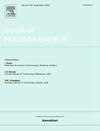Study on the mechanism of temperature fluctuation induced by coaxial jets in nuclear power systems
IF 2.3
3区 工程技术
Q1 NUCLEAR SCIENCE & TECHNOLOGY
引用次数: 0
Abstract
The mixing of fluid with different temperatures in the upper plenum results in temperature fluctuations, which can propagate to adjacent structures, potentially inducing fatigue damage. Current research primarily focuses on the temperature fluctuation characteristics of fluids and the mechanism of temperature fluctuation is still unclear. In this study, the mixing process of fluids in the upper plenum is modeled as a coaxial jet by using large eddy simulation (LES). The simulation model and method are experimentally validated. Then the distribution characteristics of the time-averaged velocity, pressure, temperature and RMS temperature at different directions and different heights are numerically obtained, respectively. By analyzing the transient temperature field, the formation mechanism of temperature fluctuation is clarified, that is, the oscillation of the central position of the cold fluid, the expansion and contraction of its control region and the changes in the shape of the region lead to the instability of the flow field.
核电系统中同轴射流引起的温度波动机理研究
不同温度的流体在上部静压室内的混合会导致温度波动,这种波动可以传播到邻近的结构,从而可能导致疲劳损伤。目前的研究主要集中在流体的温度波动特性上,温度波动的机理尚不清楚。本文采用大涡模拟(LES)方法,将上部静压室内流体的混合过程模拟为同轴射流。仿真模型和方法得到了实验验证。在此基础上,分别数值计算了不同方向和不同高度时均速度、压力、温度和均方根温度的分布特征。通过对瞬态温度场的分析,阐明了温度波动的形成机理,即冷流体中心位置的振荡、其控制区域的膨胀和收缩以及区域形状的变化导致流场的不稳定。
本文章由计算机程序翻译,如有差异,请以英文原文为准。
求助全文
约1分钟内获得全文
求助全文
来源期刊

Annals of Nuclear Energy
工程技术-核科学技术
CiteScore
4.30
自引率
21.10%
发文量
632
审稿时长
7.3 months
期刊介绍:
Annals of Nuclear Energy provides an international medium for the communication of original research, ideas and developments in all areas of the field of nuclear energy science and technology. Its scope embraces nuclear fuel reserves, fuel cycles and cost, materials, processing, system and component technology (fission only), design and optimization, direct conversion of nuclear energy sources, environmental control, reactor physics, heat transfer and fluid dynamics, structural analysis, fuel management, future developments, nuclear fuel and safety, nuclear aerosol, neutron physics, computer technology (both software and hardware), risk assessment, radioactive waste disposal and reactor thermal hydraulics. Papers submitted to Annals need to demonstrate a clear link to nuclear power generation/nuclear engineering. Papers which deal with pure nuclear physics, pure health physics, imaging, or attenuation and shielding properties of concretes and various geological materials are not within the scope of the journal. Also, papers that deal with policy or economics are not within the scope of the journal.
 求助内容:
求助内容: 应助结果提醒方式:
应助结果提醒方式:


